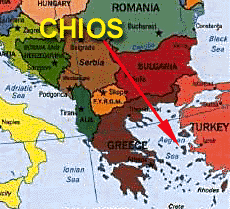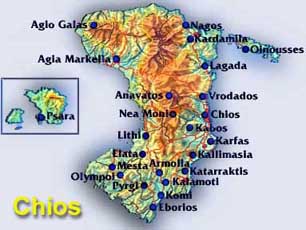The Sephardic Community of Chios (original) (raw)
Part 1.
Introduction
The Greek island of Chios is in the Northeastern Aegean sea midway between the islands of Samos and Lesvos. The island is only 5 miles (8 Km) from the west coast of Turkey, it is the fifth largest island in Greece. Documents records a a small Jewish population from at least 1049 CE to 1944 CE. Today there are no Jews living on Chios.
Location
Historically the island was known for it's wealth and large populus. The main city on the island of Chios is also called Chios. It is located on the eastern coastline looking over the straight to the Turkish mainland of Anatolia. Because of the position of its port, neighboring a rich land, and controlling the narrow passage to Constantinople, the island has always been considered geographically important.
Figure 1. Map indicating island of Chios.
Figure 2. Map of the island of Chios
Island Name Origins
There are two theories on how the island received it's name. The first is that the name Chios stems from "Chiona," who was the daughter of the island's ancient King Inopion. The other theory is that comes from the name "Hios," the son of Neptune, at the birth of whom, too much snow (hioni) fell on the island. Folklore contends Chios was the birthplace of both the Greek poet Homer in 8 BCE, and that of Christopher Columbus in 1451. Today a persons from Chios would be called a "Chiote" in Greek, and a "Chian" in English.
Spelling Variations
Jewish Population
Chios has had a Jewish population of Romanoit Jews (hellenized Latin word meaning Greek) well before the inquisition and the subsequent Iberian diaspora, and well before the Jewish "golden era." Romanoite Jews were the descendants of the Jews who were slaves brought to the Roman lands from
Palestine--which was then under Roman rule. These Jews had developed their own customs, and they spoke a language known commonly today as Judeo-Greek. Remnants of this unique tradition still survive in parts of Greece today. However, even though the Jews had a presence in Chios prior to 1492, historical records before this period only refer to a few events in the history of these island Jews.
While visiting the island around 14 BCE it was told that the non Torah compliant King Herod (King of Judea) was received by all that wanted an audience with him. Herod came to see the thriving city for himself, and paid off debts the islanders' owed to the Romans. During the visit Herod had his workers rebuild the failing sea wall and parts of the fortress where the Jews lived. Benjamin of Tudela, visited the island and met with the Jewish leaders Eliah Thiman and Schabtai. The Jewish population at the time was said to be at least 500 strong. The Venetian and Genovese left their mark, with Chios Jewish families having kept Italian surnames like Scandalli, Segala, and Gaspari. While visiting in the 14th century, the Talmud codifier and author of the Arban Tourin, Rabbi Jacob ben Asher of Toledo and his ten men fell ill and died on the island.
Throughout the dark ages and medieval years, Chios was known as a significant Mediterranean seaport as it was a landmark separating East and West. In 1346 when the Genovese took the island over, many Jewish financiers and merchants arrived with them. This is evident by the notarized seals found with Jewish Italian surnames on historical deeds from the period. The Jews were afforded security and economic prospects by the Genovese on the island. As Argenti states in The Religious Minority of Chios "they (Genovese) did not wish to kill the goose that laid the golden eggs!"
Daily Life on the Island
There was a flourishing city on Chios which thrived in trading pottery, wine, marble, silk, and mastic resin. This resin is a unique and valuable product that is produced by the mastic tree which grows only on Chios. In the past this island has been a target for various attacks and conquerors because of the importance of this product. This defensive need against foreign invaders led to the creation of defensive architecture. The most notable of such is the large Chios fortress which lies north of the island's modern capital. It played an important role in the medieval and modern history of Chios, being the center of its political and military government. At one time it enclosed the island's entire main city, but soon the town expanded outside the precinct of its walls.
Figure 4. 16th century painting of Chios. Notice the city walls (fort).
The Jews of Chios lived within this structure and in 1607 a visitor named Giust described the Juderia (known as the Ghioudeka) as the loveliest part of the fortress, "far away from the noise of the town." There were approximately 200 Jewish families living there around 1750. Their Synagogue (a wooden structure) was called Kahal Kadosh Baal ha-Turim (Holy Congregation [of the] Master of the Turim). Was probably named after the famous 14th century German born, but Spanish resident of Toledo, Spain, Rabbi Jacob ben Asher (Argenti). R' Asher (also known to history as The Tur) wrote extensively on issues dealing with Jewish worship and ritual observance in the home and synagogue.
The close relationship of the different ethnic groups was demonstrated when in 1897 a new quai was to be inaugurated on Chios, and the Grand Mufti (Muslim religious leader) of the island was to deliver the prayers. He was ill, as was his associate, so the Turkish governor requested the Chief Rabbi to deliver the prayers. The prayers were delivered in Hebrew to the audience of the Ottoman authorities, Greek Christians, and the Jewish community. (Stavroulakis, Nicholas P. Jewish Sites and Synagogues of Greece. Talos Press: Athens, 1992.)
Jewish Commerce
Documents from the 14th and 15th century discuss Jews trading in everything from soap to carpets. One notary document in particular names a Jewish grain merchant Michaeli Nicosia who was trading in wine which was grown by the islands' Jewish community.
In 1492 after the Edict of Expulsion was signed by The Catholic Kings which banished all Jews from Spain, Ottoman Sultan Bayazid II offered to accept many of these fleeing Spanish refugees. The Sultan would allow the Jews to continue to practice their own religion; this was quite different than what the Christian rulers of the same period felt--considering they thought all religions other than their own should cease to exist.
Because of it's large harbor and merchant inhabitants, Chios became one of many entry points for Sephardic Jews. Many moved on to nearby Smyrna (now Izmir) and other Ottoman lands. However, many Jews stayed on the island renewing its vigor by bringing new intellect and culture. Historical documents demonstrate a significant number of Spanish surnames within the population; and around this time Judeo-Spanish (Ladino) songs and stories took up a position in Chios tradition. The number of Sephardic Jews who arrived overwhelmed the Romaniots who were not as well educated in the religious law, or as well formed in terms of scholarly works. Eventually, Sephardic customs, language, and traditions superseded the Romaniot culture in most cities.
The Sultan was tolerant of the Jews. This can easily be seen in the fact that large Jewish communities existed in the all of the Ottoman lands until the end of the Empire. The Sephardic community even built a new synagogue on Chios as late as 1890 [however the building has since been razed, and according to the Central Board of Jewish Communities in Greece, there are no available photographs of the building]. As a non-Muslim community in the Ottoman Empire, the Jews kept their own courts, schools, and welfare systems; this type of community was known as a millet. The members of these self-run millets were pleased to have these functions in their own hands, and the Ottoman government was relieved of the necessity of providing this themselves. Religious toleration on the island was not perfect. Ottoman life was definitely Islamic life, and this gave preference to Muslims in all parts of community and government. Jews were an accepted, but lower class.

